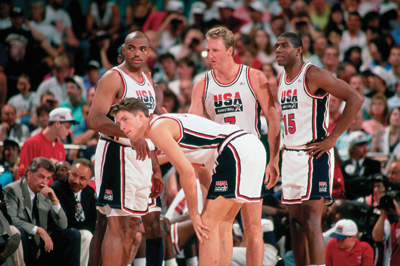During his induction into the Basketball Hall of Fame in 2013, Russ Granik quipped that his claim to fame could best be found on his Wikipedia page, which described him as the announcer of second-round picks in the NBA draft.
But in the sports world, Granik is probably best known for overseeing the incorporation of NBA players onto the U.S. Olympic team in 1992, in what famously became known as the Dream Team. While he remains proud of the accomplishment, Granik said he never has seen it as particularly reflective of his life’s work.
 |
Granik arguably is best known for working out the issues to make it possible for NBA players to play in the 1992 Olympics.
Photo by: NBAE / GETTY IMAGES
|
“It was a high point,” Granik said. “And I know that if you’re writing my story, that tends to be a key thing. I do think it was a very real accomplishment. But I was just trying to do my job as the No. 2 guy in the NBA. It wasn’t about the Olympics for me. So, to me, when I see the way it gets treated, it seems a little outsized when compared to what I did with David [Stern] for 30 years.”
Still, to hear the story, it does stand as testament to many of Granik’s strengths. Problem-solving. Negotiation. Organization. And an appreciation for basketball at all levels.
“In order for the Olympics to work, there were like a dozen pieces that had to fit into the puzzle,” said Gary Bettman, who left the league to become commissioner of the NHL shortly after the ’92 Games. “That was done through relationships. It was done through hard work. It was done through due diligence. He was terrific at managing the complexity of a complex process.”
To begin with, the NBA initially was not interested in seeing its players play. The college coaches and athletic administrators who governed USA Basketball also were opposed to it. But by 1989, after the U.S. won the bronze in the 1988 Olympics, it was clear that it would come to be in spite of their opposition.
Granik and Stern resolved that if they were going to send a team, it would be of the best players they could rally. Though they hadn’t sought it, they saw an opportunity to use the Olympics to elevate the image of the league and its stars. It would be Granik’s job to coordinate disparate factions, protecting the NBA’s suddenly critical interests. As he so often did, he found paths to compromise.
The owners insisted that the first Olympic team to include NBA players be helmed by an NBA coach, a prickly point considering that USA Basketball had a pipeline of college coaches waiting for their chance.
Working with the head of USA Basketball at the time, Big East Commissioner Dave Gavitt, Granik navigated that. They would form a selection committee to be headed by a highly regarded college athletic director, C.M. Newton of Kentucky, but made up mostly of NBA general managers recruited by Granik and NBA executive Rod Thorn.
Granik and Newton cut a deal to make Chuck Daly of the defending champion Detroit Pistons head coach, but give two of the three assistant slots to college coaches, Mike Krzyzewski and P.J. Carlesimo. There also would be a slot on the roster for one college player.
“Russ was so perfect for that job,” said Val Ackerman, then a young NBA attorney whom Granik drafted to be his right hand on the project. “He came in in a very nonthreatening way. He was able to say to the college basketball community, we’re not working against you here. We want this to be good for basketball in this country.”
The commercial issues would prove more complicated. Not only were there sponsor conflicts between the league, the Olympics and the national team, but there was the additional wrinkle of Michael Jordan and all the large brands he endorsed.
Again, they found a compromise. Jordan would appear in ads featuring the Dream Team, but they had to include every player. A company that didn’t have a deal with Jordan or Magic Johnson or Larry Bird couldn’t reach in and cherry pick them through an Olympic team sponsorship.
“The Olympic sponsors weren’t crazy about it,” Granik said, “but it got done because everybody realized it was better than him not playing.”
Of course, all did not go smoothly. At the medal ceremony, some of the Dream Team covered the Reebok logos on their awards uniforms, with Charles Barkley, Jordan and Johnson using U.S. flags.
“That was the one part of it that disappointed me,” Granik said. “I would have preferred they put towels over it than use the flag. That was the one issue that got away from me.”




